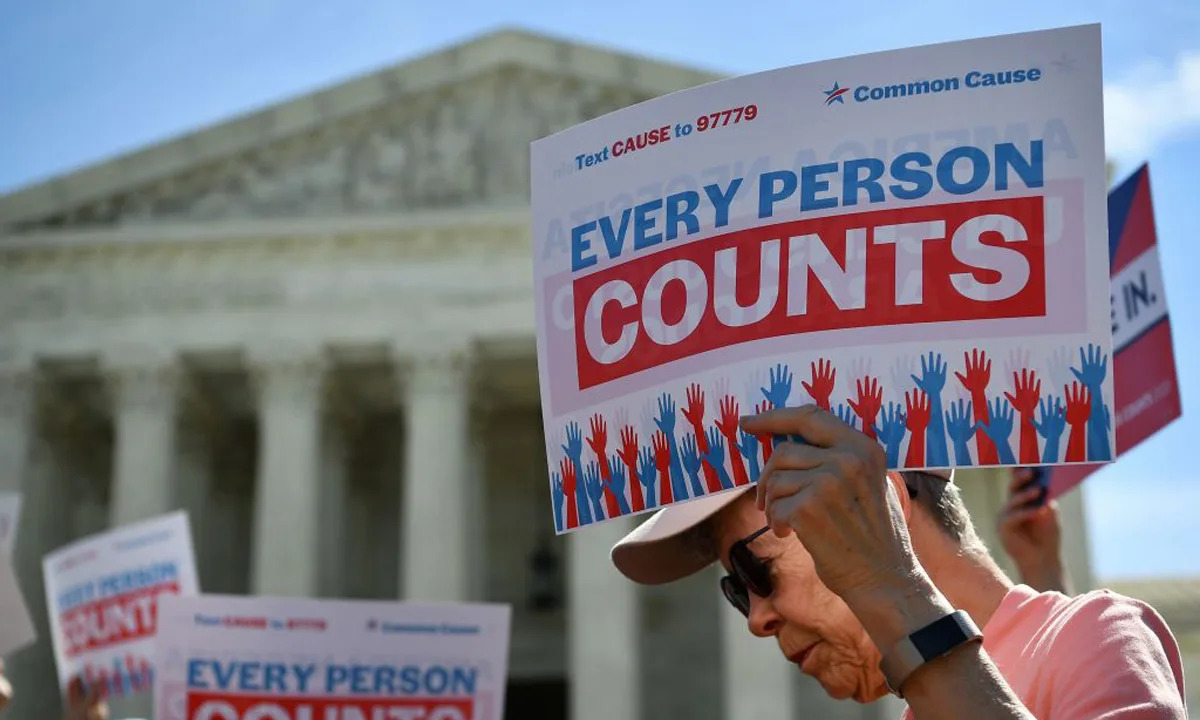
President Donald Trump has proposed removing undocumented people from an upcoming U.S. Census, a move that while difficult to execute could dramatically reduce school funding in some states, experts say.
In an early-morning Truth Social post Thursday, Trump said he told the U.S. Department of Commerce to begin work on a new census “based on modern day facts and figures” adding, “People who are in our Country illegally WILL NOT BE COUNTED IN THE CENSUS.”
The U.S. Census count is held once a decade and helps determine federal education funding. Bruce Baker, a professor at the University of Miami and a leading scholar on public school financing, said that if fewer people are counted, federal funding for schools, which is based on census data and child poverty rates, would shrink.
Get stories like this delivered straight to your inbox. Sign up for The 74 Newsletter
“The states that depend more on federal aid have the most to lose,” he said. And while the percentage of such aid is relatively small, he said, “these days, every dollar matters.”
Pew Research reports the federal government provided 13.6% of total funding for public elementary and secondary schools in fiscal 2022, according to Census Bureau data. The National Education Association said the money helps lower class size, support students with disabilities and feed hungry children. It breaks down the data by state.
Other studies confirm federal education funding varies widely across the U.S. Mississippi reported the greatest percentage of federal education aid in 2022, coming in at 23.3% followed by South Dakota at 21.7%, Montana at 20.9%, Alaska at 20.6% and Arkansas at 20.4%.
Federal money is delivered to schools in many forms. In fiscal year 2024, Pew notes, the Education Department doled out $18.8 billion for schools with large numbers of poor, neglected, delinquent and other “educationally disadvantaged” students, $15.5 billion for special education programs for children with disabilities, $5.5 billion for school improvement, and $2.2 billion for career, technical and adult education among many other grants. The federal government also spent billions on COVID recovery.
Trump’s call to revise the census comes amid massive cutbacks at the education department, changing how critical programs are implemented — and toward the end of a nail-biting summer with many in education gripped by fear after the administration temporarily withheld $7 billion in funding.
It also comes just weeks after he announced undocumented children could no longer participate in Head Start. In addition, adults without papers were banned from career and technical education programs and adult education, though both groups now have a brief reprieve.
The nation is home to some 11 million undocumented immigrants. California had 2.6 million such residents in 2022, followed by Texas, with more than 2 million and Florida which had 590,000, according to data released last year.
From Head Start to Adult Ed, Trump Narrows Pathway for Undocumented Students
This isn’t the first time Trump has tried to tinker with the U.S. Census: In his first term, he proposed the addition of a citizenship question, one critics say would have resulted in a dramatic undercount and produced a massive loss of funding in immigrant-heavy communities where even those in the country legally would be fearful of responding. The matter made its way to the Supreme Court, with Chief Justice John Roberts casting the deciding vote against the addition.
Julia Gelatt, associate director of the U.S. Immigration Policy Program at the Migration Policy Institute, said Trump could try to obtain residents’ immigration status in two ways: add questions about citizenship to the census itself, as he earlier proposed, or try to pull information from other federal data.
In either case, she said, undocumented immigrants and those who live, work and study alongside them, would lose out.
“If there are more people in a community, there is more need for infrastructure,” she said. “U.S. citizens would be hurt if that funding was insufficient.”
However, Trump’s census plan would be difficult to enact and it’s unclear when it would be implemented: Population counts take several years to plan. Also Congress, not the president, determines the manner of conducting the tally.
Trump’s intention to exclude undocumented immigrants from the census, coupled with his earlier attack on birthright citizenship, is enough to roil those concerned about the dignity of all U.S. residents.
“If you don’t count all people, you won’t be able to provide equal protection to all people,” said Alejandra Vázquez Baur, a fellow with The Century Foundation. “So this plan to not count undocumented people is a clear abandonment of that constitutional promise of equal protection.”
And with each new edict targeting the undocumented, she said, she fears the nation will inch closer to a direct attack on Plyler v. Doe, the landmark 1982 Supreme Court ruling that a child cannot be denied a public education based on immigration status.
Hayward Derrick Horton, a professor of sociology at the University of Albany, said the census impacts all areas of civic life, calling it the engine that makes society work. He noted, too, that the U.S. Census is the gold standard for data collection and is respected globally.
“So, what’s being threatened is not only the integrity of what this society is about in terms of being able to know exactly how many people we have and the allocations of the right resources to the right places, but it also invalidates this society to the world,” he said.
Horton said he believes the fear of losing a numerical majority — and the power and money that comes with it — is driving these efforts to erase an entire group — in this case, mostly Hispanic immigrants — from the census.
White people comprised 80% of the total U.S. population in 1980. Recent reports put the current figure at less than 60%. White residents will no longer be the majority by 2045, The Brookings Institution reported.
“Here in the U.S., the white population controls the wealth, status and power — and they also control the numbers,” he said.








Comments